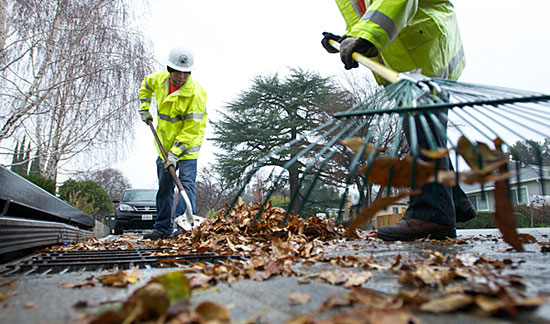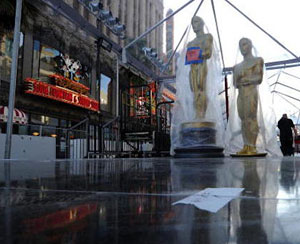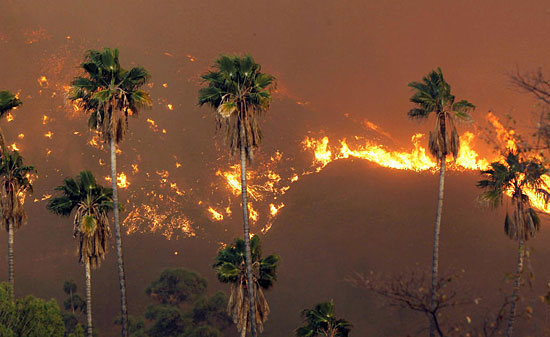Here comes the rain
February 26, 2014
The good news is that the rain has finally arrived.
Unfortunately, in some parts of Southern California, that threatens to be the bad news too.
Parched by drought and charred by wildfires, Los Angeles County has spent the week both cheering and dreading the Pacific storm systems that are predicted to soak California—and perhaps Sunday’s Academy Awards—with the wettest weather L.A. has seen since 2012.
“On one hand, the region is in sore need of drought relief, so we’re happy to have it,” says Kerjon Lee, county Department of Public Works spokesman. “But the hillsides around the Colby Fire, the Madison Fire, the Powerhouse Fire, even the Station Fire—those areas haven’t recovered.
“The hills no longer have vegetation or trees or shrubs to prevent erosion. And the upper crust of the soil has been scorched, so it’s less absorbent. Water runs across it as if it had a wax surface.”
In other words, don’t just grab an umbrella, L.A. County. Get ready for mudslides, too.
At the Department of Public Works, the situation is all-hands and the mission is twofold—first, to make sure in this drought that every possible drop of rainfall is captured, and, second, to protect local homeowners and businesses from a potential onslaught of coursing storm water and debris.
“We try not to be alarmist, but the threat right below the burn area of the Colby Fire in the foothills above Glendora is pretty serious,” Lee says.
To that end, he says, the department has been partnering not just with Glendora but with cities throughout the foothill burn areas of the San Gabriel Valley. So far, DPW engineers have advised some 700 county homeowners and businesses on ways to protect their property in the event of rain.
Public Works crews also have been working since last year with state and local agencies, the U.S. Geological Survey and others to assess risk, clean out debris basins and install crib dam structures at strategic locations in burn sites.
Drought notwithstanding, the storm preparations have been intensive. In the area of last May’s Powerhouse Fire alone, for instance, the county has installed nearly a mile’s worth of concrete barricades, or k-rail, along Walkatop, Munz Ranch, San Francisquito Canyon and Elizabeth Lake roads, plus metal standpipes at more than a dozen locations and more than 2,100 feet of embankment protection, all during the last eight months.
That’s not counting the routine storm preparations the department does every year in the county’s massive flood control system, which includes 14 major dams, 487 miles of open channels and 2,919 miles of storm drains. Or the prep work done by Los Angeles city sanitation crews, whose jobs have included clearing the catch basins near Hollywood’s Dolby Theatre, where the red carpet for Sunday’s Oscars is already out (and covered in rainproof plastic).
Nor does it include longer-term projects like La Canada’s Mullally debris basin, which was expanded in late 2010 after winter storms the prior year clogged its drainage system. (Debris from the 2009 Station Fire had been brought down by the rainstorms, and the backup had inundated nearby homeowners with a wall of mud.)
While DPW crews try to prevent storm water from inundating local roadways, county “storm boss” Michele Chimienti , who heads dam operations for the department’s water resources branch, will be trying to save as much of it as possible.
This week’s storms, heavy as they may end up being, won’t reverse the drought that has dogged California for the past three years; in fact, the overall lack of precipitation has been such a concern that this week, the Board of Supervisors extended the county’s lease on its two Super Scooper fire-fighting aircraft.
But one function of the county dams is to gather water that can be released periodically to replenish the underground aquifers that, in turn, generate about a third of the region’s drinking water.
Right now, Lee says, most of those dams are at less than 5% capacity, so there’s plenty of room for more.
While the county battens down the hatches of its infrastructure, homeowners can make their own storm preparations.
Appearing before the Board of Supervisors this week, Public Works Director Gail Farber reminded the public that the county’s Coordinated Agency Recovery Effort web site will be updated as the storm progresses with information on road conditions, flooding, forecasts, emergency contacts, disaster preparedness and assistance programs. (For details, click here.)
The Los Angeles County Sheriff’s Department suggests that, if you haven’t already, you should sign up for free public safety alerts from the department via Nixle. They also are offering tips on storm-proofing your vehicle—and your driving habits.
DPW also has this handy list of places to obtain free sandbags and this free guide to flash flood preparedness. For homeowners interested in rain barrels, the City of Los Angeles offers this guide to rainwater harvesting.
And one more bit of advice from the experts: Don’t forget to turn off your sprinklers. With any luck, the upside of this storm will carry over onto your water bill.
Posted 2/26/14















 405 bridge work causes a stink
405 bridge work causes a stink
